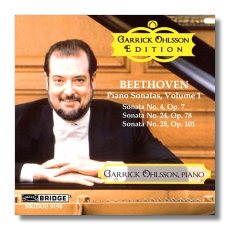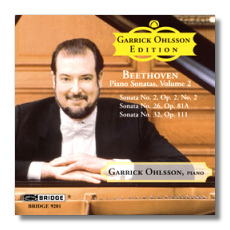
The Internet's Premier Classical Music Source
Related Links
- Beethoven Reviews
- Latest Reviews
- More Reviews
-
By Composer
-
Collections
DVD & Blu-ray
Books
Concert Reviews
Articles/Interviews
Software
Audio
Search Amazon
Recommended Links
Site News
 CD Review
CD Review
Ludwig van Beethoven

Piano Sonatas, Volume 1
- Piano Sonata #4
- Piano Sonata #24
- Piano Sonata #28
Garrick Ohlsson, piano
Bridge 9198 DDD 64:02


Piano Sonatas, Volume 2
- Piano Sonata #2
- Piano Sonata #26 "Lebewohl"
- Piano Sonata #32
Garrick Ohlsson, piano
Bridge 9201 DDD 71:17
Garrick Ohlsson, who won the Chopin International Piano Competition in 1970, has recorded the better part of that composer's piano works twice, but as far as I know, he has not recorded Beethoven's complete piano sonatas, although he seems to have been on the road to doing so at different points in his career. Given the quality of these two releases (labeled Volume 1 and 2), I hope that this is a project he will take to its completion with Bridge Records.
When any pianist starts such a project, it is fair to ask what he or she will bring to this repertoire that has not been said already. Beethoven sonata cycles, starting with Schnabel, are not rare, after all. Ohlsson's Beethoven, while not really unusual, still has merit because of the things that he does that make these performances his… an unexpected tempo here, an intriguing bit of phrasing there, and so on. The listener is made comfortable, knowing that he or she is in good hands, but is not bored.
Of these two discs, Volume 2 (Bridge 9201) probably is the place to start. First of all, the repertoire is more interesting. Second of all, Harris Goldsmith's erudite booklet notes have something interesting to say even to listeners who have known these sonatas for decades. Third and most of all, however, is Ohlsson's solid musicianship, which is nine parts responsibility and one part surprise. I'm not sure why he elected not to do the exposition repeat in the first movement of Sonata #2, particularly because he doesn't make such a decision elsewhere, and the movement's (and sonata's) structure would seem to call for it. Regardless, this is a performance that captures all of the young Beethoven's changing moods, from humor (both gentle and roughhousing), charm, and tenderness, to imperiousness and sudden fits of temper. Ohlsson starts the opening Adagio of the "Lebewohl" (or "Les Adieux") sonata unusually slowly, but by the time he reaches the Allegro he is at a fairly standard tempo, with clear articulation and a controlled sense of drama. The middle movement also is played slowly, and with unexaggerated pathos. In the final movement, depicting the return of Beethoven's friend and patron, Archduke Rudolph, Ohlsson allows Beethoven a moment of overexcitement, turning the score's slurred pairs of 16th notes into something closer to pairs of a grace note and an 8th note. If the movement, as a whole, lacks the excitement that some other pianists have brought to it, Ohlsson is not dull, and the cleanness of his playing has its own rewards.
Sonata #32 is distinguished by a glorious reading of the second movement, particularly in the latter portion, where with murmurs and trills, Beethoven makes the theme ascend into the stratosphere. Here, Ohlsson's technique serves him particularly well; even at a whisper of sound, his playing has color and is remarkably even. There's no point in pianists performing this music if they cannot make it into an ethereal, spiritual experience, and Ohlsson succeeds better than most in making this sonata the transcendent experience that it should be.
Both discs have been produced, engineered, and edited by Adam Abeshouse. The sound is pretty close to ideal. Interestingly, the instruments are different from one disc to the next. Volume 1 was played on a Steinway, while Volume 2 was played on a 1919 Mason and Hamlin concert grand, rebuilt by William Schneider of Michigan State University.
Copyright © 2007, Raymond Tuttle




















